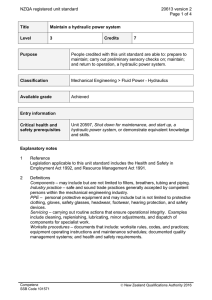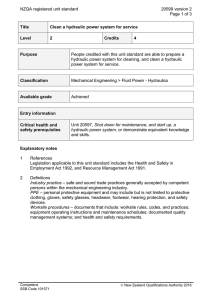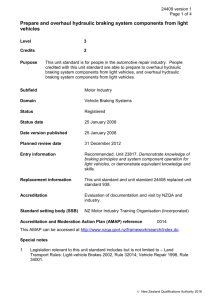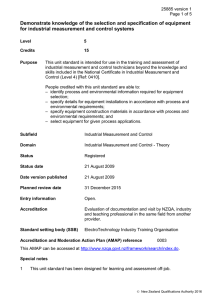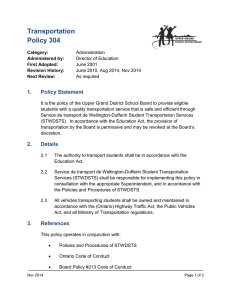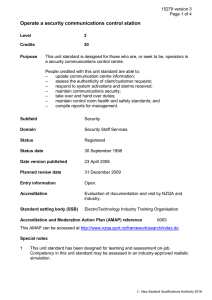Test and service hydraulic systems on equipment, vehicles, and/or machines
advertisement
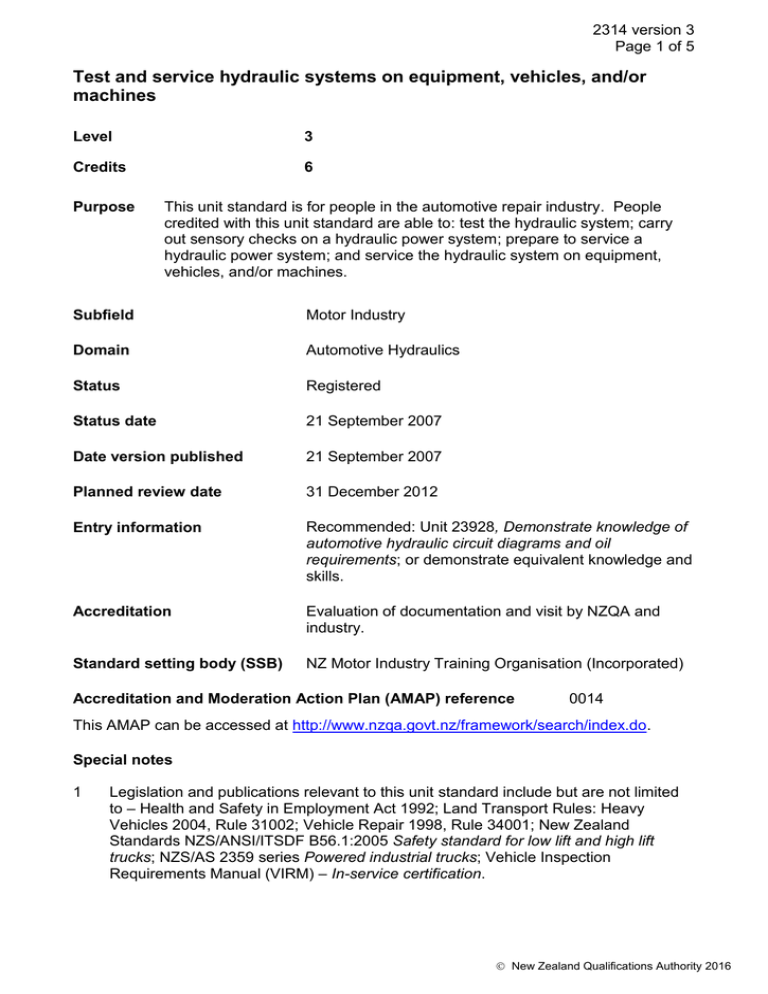
2314 version 3 Page 1 of 5 Test and service hydraulic systems on equipment, vehicles, and/or machines Level 3 Credits 6 Purpose This unit standard is for people in the automotive repair industry. People credited with this unit standard are able to: test the hydraulic system; carry out sensory checks on a hydraulic power system; prepare to service a hydraulic power system; and service the hydraulic system on equipment, vehicles, and/or machines. Subfield Motor Industry Domain Automotive Hydraulics Status Registered Status date 21 September 2007 Date version published 21 September 2007 Planned review date 31 December 2012 Entry information Recommended: Unit 23928, Demonstrate knowledge of automotive hydraulic circuit diagrams and oil requirements; or demonstrate equivalent knowledge and skills. Accreditation Evaluation of documentation and visit by NZQA and industry. Standard setting body (SSB) NZ Motor Industry Training Organisation (Incorporated) Accreditation and Moderation Action Plan (AMAP) reference 0014 This AMAP can be accessed at http://www.nzqa.govt.nz/framework/search/index.do. Special notes 1 Legislation and publications relevant to this unit standard include but are not limited to – Health and Safety in Employment Act 1992; Land Transport Rules: Heavy Vehicles 2004, Rule 31002; Vehicle Repair 1998, Rule 34001; New Zealand Standards NZS/ANSI/ITSDF B56.1:2005 Safety standard for low lift and high lift trucks; NZS/AS 2359 series Powered industrial trucks; Vehicle Inspection Requirements Manual (VIRM) – In-service certification. New Zealand Qualifications Authority 2016 2314 version 3 Page 2 of 5 2 Land Transport Rules are produced for the Minister of Transport by Land Transport New Zealand. These rules are available online at http://www.landtransport.govt.nz/rules/. New Zealand Standards are available from Standards New Zealand, Private Bag 2439, Wellington; phone 04 498 5990; or website http://www.standards.co.nz. The VIRM is published by Land Transport New Zealand and is available online at http://www.landtransport.govt.nz/certifiers/virm-in-service/index.html. 3 Definitions Service information may include but is not limited to – technical information of a vehicle, machine, or product detailing operation; installation and servicing procedures; manufacturer instructions and specifications; technical terms and descriptions; and detailed illustrations. This can be accessed in hard copy or electronic format and is normally sourced from the manufacturer. Suitable tools and equipment means industry approved tools and equipment that are recognised within the industry as being the most suited to complete the task in a professional and competent manner with due regard to safe working practices. 4 For this unit standard, it is essential that the practical assessment evidence is obtained in the workplace under normal workplace conditions. Elements and performance criteria Element 1 Test the hydraulic system on equipment, vehicles, and/or machines. Performance criteria 1.1 Safe working practices are observed throughout the task in accordance with legislative requirements. Range working with high pressure fluid, disabling circuits, supporting raised components, disconnecting components with load relieved. 1.2 Hydraulic circuit diagrams for hydraulic equipment are identified in accordance with service information. 1.3 Suitable tools and test equipment which enable the system to be tested are selected and used in accordance with service information. 1.4 The hydraulic oil condition is checked and the system level is correct before any testing is carried out. Range oil condition – foamy, milky, smell, overheated, dirty, metallic particles present. New Zealand Qualifications Authority 2016 2314 version 3 Page 3 of 5 1.5 The system is tested for correct operation in accordance with service information, and the results are recorded. Range 1.6 inspection for leaks; damaged hoses; noisy operation; vibration; excessive heat; slow, erratic and/or non-operation of the system; pressure testing; flow testing. A report on the condition of the system with comparison to manufacturer specifications is given to the supervisor. Element 2 Carry out sensory checks on a hydraulic power system on equipment, vehicles, and/or machines. Range senses – sight, sound, touch, smell; checks may include but are not limited to – leaks, levels, hose condition, filters, couplings, temperatures, gauges and indicators, excessive or unusual noise, fluid odour. Performance criteria 2.1 Checks are carried out in accordance with service information and legislative requirements. 2.2 Results are checked in accordance with service information, interpreted, and verified with the supervisor. Element 3 Prepare to service a hydraulic power system on equipment, vehicles, and/or machines. Performance criteria 3.1 Safe working practices are observed throughout the task in accordance with legislative requirements. Range 3.2 Suitable tools and equipment are selected to maintain a hydraulic power system in accordance with service information. Range 3.3 personal safety, safety of others, equipment and machine safety. may include but is not limited to – containers, blanking flanges, plates and plugs, absorbent materials, hand tools, cleaning equipment and fluids. Hydraulic power system is made safe in accordance with service information and is confirmed with supervisor in accordance with company requirements. Range may include but is not limited to – isolation, depressurisation, Personal Protective Equipment (PPE), safety supports. New Zealand Qualifications Authority 2016 2314 version 3 Page 4 of 5 3.4 System and adjacent environment are cleaned, and waste is disposed of in accordance with company requirements. Element 4 Service the hydraulic system on equipment, vehicles, and/or machines. Performance criteria 4.1 Suitable tools and equipment are selected and used that enable hydraulic system faults to be repaired in accordance with service information. Range 4.2 Safety precautions are taken before work is started in accordance with legislative requirements and service information. Range 4.3 may include but is not limited to – containers, blanking flanges, plates and plugs, absorbent materials, hand tools, cleaning equipment and fluids. engine stopped, hydraulic pressure removed, suspended loads lowered and/or blocked. The system is drained and the oil replaced in accordance with service information. Range type, grade, level. 4.4 System service requirements are completed in accordance with service information. 4.5 Hydraulic connections to be opened are cleaned before being opened; and the unused openings are plugged in accordance with service information. 4.6 Leaks are repaired in accordance with service information. Range 4.7 Components are removed in accordance with service information. Range 4.8 may include but is not limited to – pump, cylinders, control valves, relief valves, actuators, oil cooler, motors. Components are replaced without damage to the system or component in accordance with service information. Range 4.9 may include but is not limited to – damaged hoses, seals, pipes, connections. may include but is not limited to – pump, cylinders, control valves, relief valves, actuators, oil cooler, motors. Fluid samples are collected for analysis in accordance with sampling company’s specified procedures. New Zealand Qualifications Authority 2016 2314 version 3 Page 5 of 5 4.10 The system is retested for oil leaks and correct operation in accordance with service information. Please note Providers must be accredited by NZQA, or an inter-institutional body with delegated authority for quality assurance, before they can report credits from assessment against unit standards or deliver courses of study leading to that assessment. Industry Training Organisations must be accredited by NZQA before they can register credits from assessment against unit standards. Accredited providers and Industry Training Organisations assessing against unit standards must engage with the moderation system that applies to those standards. Accreditation requirements and an outline of the moderation system that applies to this standard are outlined in the Accreditation and Moderation Action Plan (AMAP). The AMAP also includes useful information about special requirements for organisations wishing to develop education and training programmes, such as minimum qualifications for tutors and assessors, and special resource requirements. Comments on this unit standard Please contact the NZ Motor Industry Training Organisation (Incorporated) janet.lane@mito.org.nz if you wish to suggest changes to the content of this unit standard. New Zealand Qualifications Authority 2016
